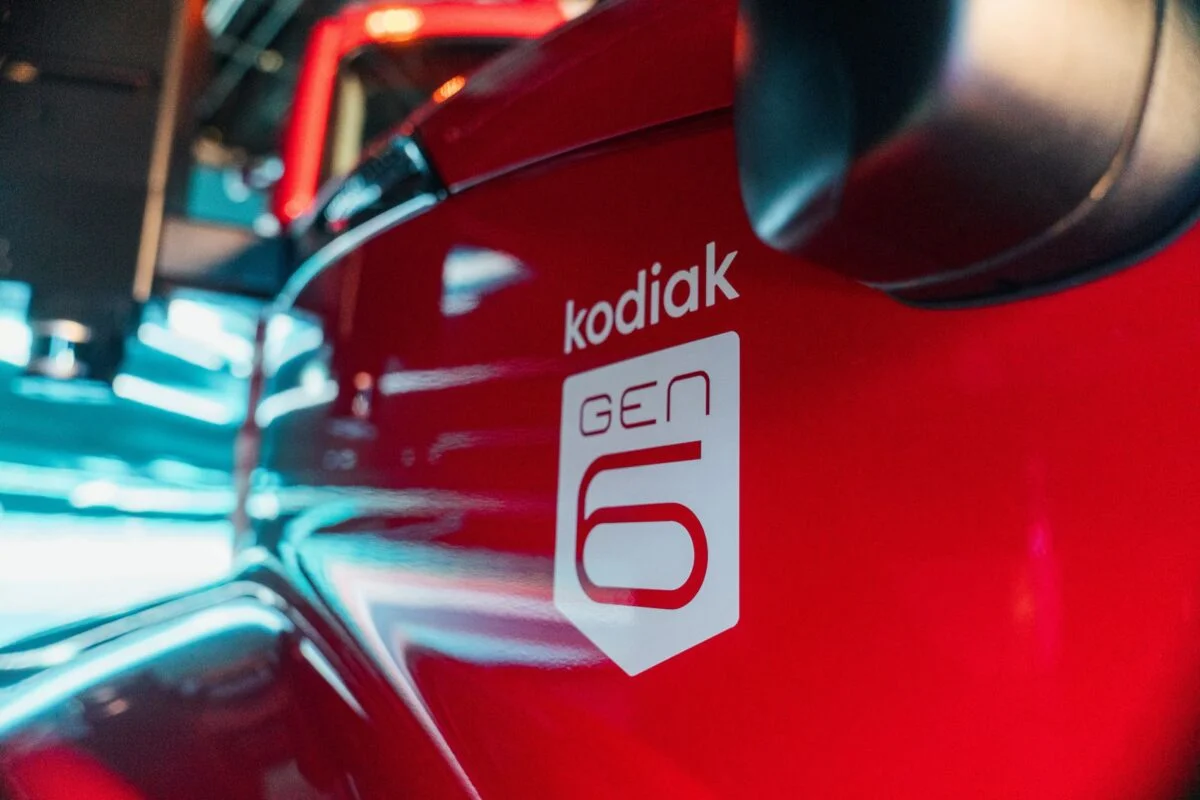LAS VEGAS — Kodiak Robotics on Tuesday revealed its sixth-generation Class 8 autonomous truck, a production-ready model it plans to launch without a human driver later this year in Texas.
After five years of testing and 5,000 driver-monitored autonomous loads covering more than 2.5 million miles, Kodiak reached the finish line with a system capable of being retrofitted on any major Class 8 truck. Kodiak will upfit Kenworth T680s with its redundant braking, steering, power and sensors that provide backup in case of a primary system outage.
The driverless design is now feature-complete across automotive-grade hardware and software, the company said. Kodiak in June announced an order from Loadsmith for up to 800 of the Kodiak Driver systems beginning in late 2025.

Kodiak and Aurora take different approaches to driverless rollout
Mountain View, California-based Kodiak and Pittsburgh-based rival Aurora Innovation both plan commercial driverless operations from Houston to Dallas this year.
Aurora’s approach is different. It partnered with Paccar Inc. and Volvo Group on redundant chassis designs for its robotic driving system. Aurora also is working with Tier 1 supplier Continental AG on automotive-grade hardware expected in 2027.
“While we are working closely with OEM partners to develop our technology, we have intentionally developed the Kodiak Driver so that we are not dependent on OEMs to commercialize,” Kodiak founder Don Burnette told FreightWaves. “While OEMs are making great strides, progress is slow, and some are still years away from offering a driverless-ready truck platform.
“By building our own driverless-ready truck, we can maintain control over how and when we bring our technology to market. We believe this approach is unique in the industry. In the long run, we expect that our technology will be direct from the OEMs. But we think our approach will give us an advantage for the next few years.”
Kodiak in December showed a prototype system installed on a Ford F-150 pickup truck for off-highway use by the military. It plans to roll out its latest system to multiple vehicle types.
“Over the course of 2.5 million miles, we’ve successfully demonstrated that our self-driving trucks can withstand the harsh environment of long-haul trucking from both a platform integrity and a software perspective,” Burnette said. “This truck fundamentally demonstrates that we’ve done the work necessary to safely handle driverless operations.”

Safety redundancy
Kodiak’s pneumatic braking system consists of three individual brake actuators simultaneously controlled by Kodiak’s proprietary software. Should any of the braking actuators fail, the backup systems can prevent loss of control and bring the truck to a safe stop.
The dual-redundant steering system includes two redundant ZF actuators controlled by Kodiak’s safety system. If the primary steering actuator experiences any type of failure, the steering system seamlessly switches to the secondary actuator to maintain full control.
Kodiak’s custom-designed, high-integrity safety computer ensures the Kodiak Driver can guide the truck to a safe “fallback” out of the flow of traffic in the event of a critical system failure.
Kodiak’s sixth-generation truck features twice the graphics processing unit cores, 1.6-times greater processing speed, 3 times more memory, and 2.75 times greater bandwidth to run software processes compared to Kodiak’s first-generation truck.
The redundant power system for computers, sensors, actuators and other electrical systems is split into two fully isolated subsystems. That ensures all safety systems can execute a safe fallback should either fail.
Upgraded features
Kodiak’s proprietary SensorPods — pre-calibrated and pre-built for fast and easy repairs– now have two automotive grade higher-resolution light detecting and ranging (lidar) sensors. Two additional side radar sensors improve long-range object detection.
In total, the Kodiak driverless-ready truck features 12 cameras, four lidar sensors, and six radar sensors. Nvidia GPUs handle the high-performance compute functions.
Later in 2024. Kodiak will integrate a next-generation Ambarella CV3-AD AI domain control system-on-chip to continuously improve the truck’s sensor and machine-learning capabilities.
The SensorPods also have top-mounted, extra-bright hazard lights. Kodiak hopes these will replace road flares when a Kodiak truck is parked on the side of the road. Their use is pending Federal Motor Carrier Safety Administration approval.
Going to market
Kodiak has designed its self-driving system to work on any truck.
“Over the next two years, Kodiak will work with our customers to determine the make and model of the trucks that will best fit into their fleets,” Burnette said. “Customers will order the trucks from a dealership. Kodiak and our upfit partners will equip them with our self-driving system, including hardware and software.”
An upfit will take about four weeks.
Kodiak plans to offer a driver-as-a-service model, charging customers a per-mile fee to use the Kodiak Driver on the customers’ trucks.
“We believe the Kodiak Driver will eventually be available on every make and model truck,” Burnette said.
Related articles:
Kodiak Robotics makes autonomous pickup for military
Loadsmith orders 800 Kodiak Robotics autonomous truck systems







Larry Neumann
Destruction of jobs with minimal savings for consumers. They can automate every last truck driver job and the price we pay for products will be very much the same price it is now. Automation mania is the absolute greatest threat to workers. And the families they have supported.
Management pay will skyrocket. So too will the number of worker’s unemployed or under employed.